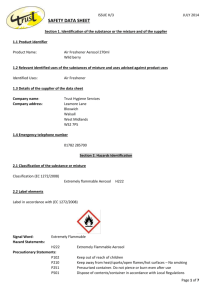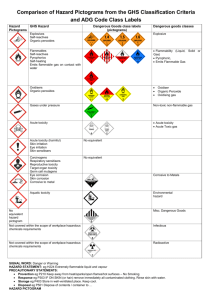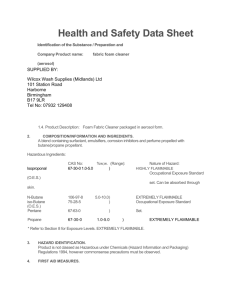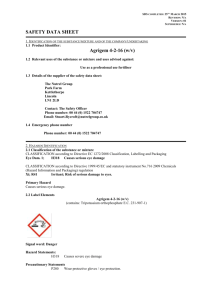belgravia - 795139 - Trust Hygiene Services
advertisement
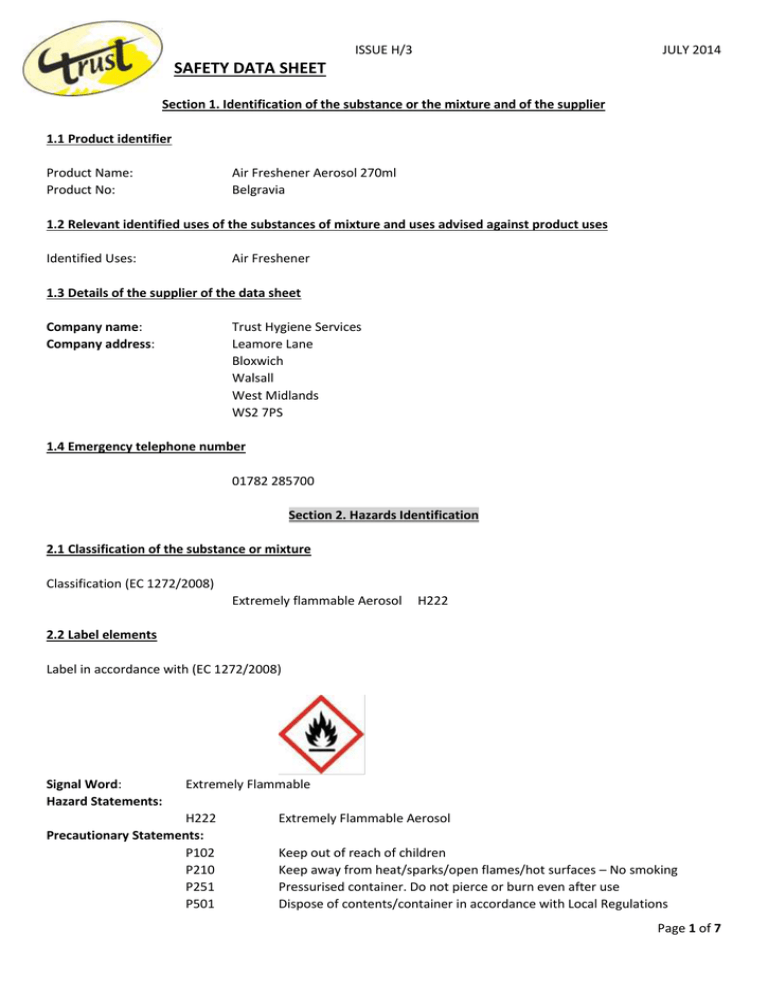
ISSUE H/3 JULY 2014 SAFETY DATA SHEET Section 1. Identification of the substance or the mixture and of the supplier 1.1 Product identifier Product Name: Product No: Air Freshener Aerosol 270ml Belgravia 1.2 Relevant identified uses of the substances of mixture and uses advised against product uses Identified Uses: Air Freshener 1.3 Details of the supplier of the data sheet Company name: Company address: Trust Hygiene Services Leamore Lane Bloxwich Walsall West Midlands WS2 7PS 1.4 Emergency telephone number 01782 285700 Section 2. Hazards Identification 2.1 Classification of the substance or mixture Classification (EC 1272/2008) Extremely flammable Aerosol H222 2.2 Label elements Label in accordance with (EC 1272/2008) Signal Word: Hazard Statements: Extremely Flammable H222 Precautionary Statements: P102 P210 P251 P501 Extremely Flammable Aerosol Keep out of reach of children Keep away from heat/sparks/open flames/hot surfaces – No smoking Pressurised container. Do not pierce or burn even after use Dispose of contents/container in accordance with Local Regulations Page 1 of 7 ISSUE H/3 JULY 2014 Supplementary Precautionary Statements: P273 Avoid release into the environment P305+351+338 IF IN EYES: Rinse cautiously with water for several minutes. Remove contact lenses, if present and easy to do. Continue rinsing. P370+378 In case of fire: Use carbon dioxide, dry chemical, foam for extinction. P410+412 Protect from sunlight. Do not expose to temperatures exceeding 50ᴼC/122ᴼF. 2.3 Other hazards: None Sections 3. Composition / information on ingredients 3.2 Mixtures Contains: Name CAS Petroleum Gases Liquified Ethyl alcohol EC 75-09-2 64-17-5 270-704-2 200-578-6 % 70-80% <11.2% 5-(2,2,3-trimethyl-365113-99-7 265-453-0 <0.04% cyclopentenyll-3methylpentan-2-o1 6-octen-1-ol,3,7-dimethyl 106-22-9 203-375-0 <0.03% (L) acetyl cedrene 32388-55-9 251-020-3 <0.19% d-para-mentha-1,8-diene 5989-27-5 <0.04% Linalyl acetate 116-95-7 204-116-4 <0.18% The full text for Hazard and Precautionary statements are listed in Section 16. Classification for (CLP) 1272/2008 Flam Gas 1_H220 FL 2-EDI 2;H225H319,N; R 50/53 Xi-N;R 38-43-51/53 Xi-N; R 43-50/53 Xi-?N; R 10-38-43-50/53-65 N; R 51/53 Section 4. First-aid measures 4.1 description of first aid measures IF IN EYES: Rinse cautiously with water for several minutes. Remove contact lenses, if present and easy to do. Continue rinsing. 4.2 Most important symptoms and effect, both acute and delayed. Causes eye irritation. 4.3 Indication of any immediate medical attention and special treatment needed. None expected, see section 4.1 for further information. Section 5: Firefighting measures 5.1 Extinguishing media Suitable media: Carbon dioxide, Dry chemical, Foam. 5.2 Special hazards arising from the substance or mixture. Page 2 of 7 ISSUE H/3 JULY 2014 In case of fire, may be liberated: carbon monoxide, unidentified organic compounds. 5.3 advice for fire fighters: In case of insufficient ventilation, wear suitable respiratory equipment. Section 6. Accidental release measures 6.1 personal precautions, protective equipment and emergency procedures: Avoid inhalation. Avoid contact with skin and eyes. See protective measures under section 7 and 8. 6.2 Environmental precautions: Keep away from drains, surface and ground water, and soil. 6.3 Methods and material for containment and cleaning up: Remove ignition sources. Provide adequate ventilation. Avoid excessive inhalation of vapours. Contain spillage immediately by use of sand or inert powder. Dispose of according to local regulations. 6.4 reference to other sections: Also refer to sections 8 and 13. Section 7. Handling and storage 7.1 Precautions for safe handling: Keep away from heat, sparks, open flames and hot surfaces. – No smoking. 7.2 Conditions for safe storage, including any incompatibilities. Protect from sunlight. Do not expose to temperatures exceeding 50ᴼC/122ᴼF 7.3 Specific end use(s): Use in accordance with good manufacturing and industrial hygiene practises. Section 8. Exposure controls/personal protection 8.1 Control Parameters Workplace exposure limits: Ingredient CAS EC Petroleum 75270- STD WEL TWA – 8 Hrs 100ppm (Sk) STEL- 15 Min 300ppm (Sk) Reference UK EH40 Oct Page 3 of 7 ISSUE H/3 Gases Liquefied Ethyl alcohol 09-2 704-2 6417-5 200578-6 JULY 2014 2007 WEL 1000 ppm(Sk) 1920 ppm (Sk) UK EH40 Oct 2007 8.2 Exposure Controls Eye/Skin Protection Respiratory protection Section 9. Physical and chemical properties 9.1 Information on basic physical and chemical properties Appearance: Odour Initial boiling point/range: Flash point: Vapour pressure: Relative density: Solubility (ies): Aerosol As per fragrance -40°C - -2°C -60°C Aerosol pressurised to 70 psi 0.598 Soluble in alcohol, hydrocarbon solvents. Partially soluble in water. 9.2 Other information None available Section 10.Stability and reactivity 10.1 Reactivity: Presents no significant reactivity hazard, by itself or in contact with water. 10.2 Chemical stability Good stability under normal storage conditions. 10.3 Possibility of hazardous reactions: Not expected under normal conditions of use. 10.4 Conditions to avoid: Avoid extreme heat 10.5 Incompatible materials: Avoid contact with strong acids, alkalis or oxidising agents. Page 4 of 7 ISSUE H/3 JULY 2014 10.6 Hazardous decomposition products: Not expected Section 11. Toxicological information 11.1 Information on toxicological effects This mixture has not been tested as a whole for health effects. The health effects have been calculated using the conventional method outlines in article 6(1)(a) of directive 1999.45.EC, in accordance with regulation (EC) No 1907/2206 (REACH). In addition, toxicity information for the mixture, if available, is provided below in accordance with methods given in regulation (EC) No 1272/2008. Assumed toxicity value (LD50 or ATE) for acute oral toxicity: Assumed toxicity value (LD50 or ATE) for acute dermal toxicity: Assumed toxicity value (LD50 or ATE) for acute inhalation toxicity: Inhalation route: Not applicable. Not applicable. Not available. Not available. Information about hazardous ingredients in the mixture Not applicable. Refer to sections 2 and 3 additional information. Section 12. Ecological information 12.1 Toxicity: Not available 12.2 Persistence and degradability: Not available. 12.3 Boiaccumalative potential: Not available. 12.4 Mobility in soil: Not available. 12.5 Results pf PBT and vPvB assessment: This substance does not meet the PBT/vPvB criteria of REACH, annex XIII. 12.6 Other adverse effects: Not available. Section 13. Disposal considerations 13.1 Waste treatment methods: Dispose of in accordance with local regulations. Avoid disposing into drainage systems and into the environment. Empty containers should be taken to an approved waste handling site for recycling or disposal. Section 14. Transport information 14.1 UN Number UN No (ADR/RID/ADN) UN No (IMDG) UN NO (ICAO) 1950 1950 1950 14.2 UN Proper Shipping Name AEROSOLS 14.3 Transport Hazard Class ADR/RID/AND Class 2.1 Page 5 of 7 ADR/RID/AND Class ADR Label No IMDG Class ICAO Class/Division ICAO Subsidiary Risk ICAO TEC* No Air Class UK Road Class Transport Labels ISSUE H/3 Class 2: Gases 2.1 &6.1 2.1 2.1 6.1 20GSF 2.1 2.1 L.Q. JULY 2014 14.4 Packing Group Not Applicable 14.5 Environmental Hazards Not environmentally hazardous for transport 14.6 Special Precautions for user None additional 14.6 Transport in bulk according to Annex II of MARPOL73/78 and the IBC code Not applicable Section 15. Regulatory information 15.1 Safety, health and environmental regulations/legislation specific for the substance or mixture: Statutory instruments The chemicals (Hazard information and packaging for supply) regulations 2009 (S.I 2009 No. 716). Control of substances hazardous to health. Approved code of practice. Classification and labelling of substances and preparations dangerous for supply. Safety data sheets for substances and preparations. Guidance notes Workplace exposure limits EH40. Introduction to Local exhaust ventilation HS(G)37. CHIP for everyone HSG(108). EU Legislation Dangerous substance directive 67/548/EEC. Dangerous preparations directive 1999/45/EC. Regulation (EC) No 1907/2006 of the European parliament and of the council of 18 December 2006 concerning the registration, evaluation, authorisation and restriction of chemicals (REACH), establishing a European Chemicals agency, amending directive 1999/45/EC and repealing council regulation (EEC) No 793/93 and commission regulation (EC) No 1488/94 as well as council directive 76/769/EEC and commission directives 91/155/EEC, 93/67/EEC, 93/105/Ec and 2000/21/EC, including amendments. 15.2 Chemicals safety assessment Page 6 of 7 ISSUE H/3 A chemical safety assessment has not been carried out for this product. JULY 2014 Section 16. Other information General Information: This product should be used as directed. For further information consult the product data sheet or contact Technical services. Information sources: This Safety Data Sheet was compiled using current safety information supplied by the distributor of raw materials. Classification under regulation (EC) No 1272/2008 Class and category of Signal word: Hazard statements: Flammable liquid, hazard category 1 Extremely Flammable H222, extremely flammable aerosol Precautionary Statements: P201 Keep out of reach of children P210, Keep away from heat, sparks, open flames and hot surfaces. – No smoking. P251 Pressurised container. Do not pierce or burn, even after use. P273 Avoid release into the environment. P305/351/338, IF IN EYES: Rinse cautiously with water for several minutes. Remove contact lenses, if present, and easy to do. Continue rinsing. P370/378, In case of fire: Use carbon dioxide, dry chemical, foam for extinction. P501, dispose of contents/container to approved disposal site, in accordance with local regulations. P410+412 Protect from sunlight. Do not expose to temperatures exceeding 50ᴼC/122ᴼF. ISSUE: REVISION DATE: REVIEW DATE: H/3 JULY 2014 JULY 2016 This advice is given by AFT Aerosols Ltd, who accept no legal liability for it. The information herein is based on the present state of our knowledge, and is intended to describe our products from the point of view of safety requirements. It should not, therefore, be construed as guaranteeing specific properties. Page 7 of 7
